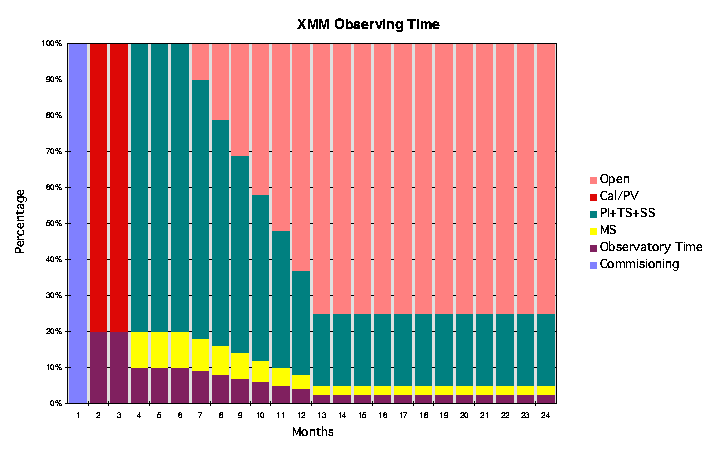 |
The total available XMM time will be subdivided into several categories, as shown in Fig. 83.
Observations as part of the XMM Guest Observer (GO) programme will commence approximately six months after launch. Starting at that time, the GO share of the total observatory time will increase to 75%, at which it will stay for the remainder of the first 27 months in orbit.
The XMM Science Management Plan (SMP; ESA/SPC(88)20) identifies four phases of activity during the first two years of XMM operations. These are:
The commissioning phase, including outgassing of payload and spacecraft, in-orbit switch-on and check-out, is expected to last for ca. four weeks. During this period basic engineering checks on the system will also be performed.
This time is allocated to a first characterisation of the telescope and instruments, to determine sensitivities etc. It is expected to last about 11-12 weeks.
During this phase 80% of the observatory time is set aside for the Principal Investigators (PIs), Telescope Scientist (TS), Project Scientist (PS) and Survey Scientist (SS) and the Observatory Team. The remaining 20% of the time are Mission Scientist (MS) and Observatory time (10% each).3 This phase will last for three months and terminate approximately six months after launch.
During the second six month period of the first year in orbit, open time proposals will be interleaved with the guaranteed time observations such that, on the average, the time is split 50/50, with a linear run of the guaranteed time from 80% at the beginning to 20% at the end of the period.
After the completion of the second six-month period, until the end of AO-1, 75% of the time will be open for GO proposals, 20% for guaranteed time observations. 5% are allocated as Observatory Time.
Although the approved implementation of the XMM mission is only for a duration of 27 months, the expected lifetime is ca. 10 years.
The expected spacecraft observing efficiency (time available for science observation out of the total observatory time) is about 70%. Therefore, the total amount of GO time available, starting with the second year in orbit, is ca. 12.35 Ms per year. In AO-1, a total of about 13.9 Ms will be available for GO observations.